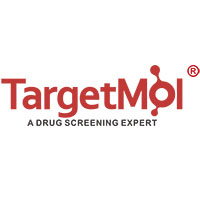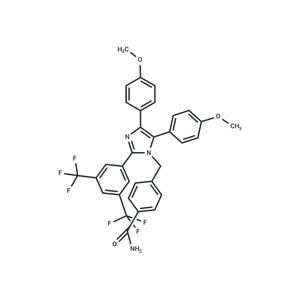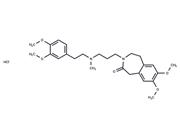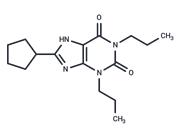| Name | Apoptozole |
| Description | Apoptozole (Apoptosis Activator VII) inhibits the ATPase domain of Hsc70 and Hsp70, inducing apoptosis. |
| Cell Research | Several cancer cell lines (A549, lung adenocarcinoma epithelial cells; HeLa, cervical cancer cells; MDA-MB-231, breast cancer cells; HepG2, liver cancer cells) are treated with various concentrations (0-15 μM) of Az or compound 7 as a negative control for 18 hr. Cell viabilities are then determined using an MTT assay.(Only for Reference) |
| Kinase Assay | Inhibition of HER2/erbB2 tyrosine kinase activity: BT-474 cells are seeded on 24-well plates and cultured overnight. Mubritinib is then added at various concentrations. After incubation for 2 hours, the cells are harvested directly into sodium dodecyl sulfate (SDS)-sample buffer (200 μL). Aliquots containing equal amounts of total cell extract are run on 7.5% to 15% gradient SDS–polyacrylamide gel electrophoresis (PAGE). Following electrophoresis, proteins are transferred onto a polyvinylidene fluoride (PVDF) membrane, for western blot analysis using a relevant primary antibody. Detection of protein is accomplished by an enhanced chemiluminescent (ECL) detection method. The extent of tyrosine phosphorylation of HER2/erbB2 is measured by the LAS-1000 plus lumino-image analyser. The concentration of Mubritinib that inhibits HER2/erbB2 phosphorylation by 50% (IC50) is calculated from a dose–response curve generated by least-squares linear regression of the response using SAS software. |
| In vitro | Apoptozole induces caspase dependent apoptosis by blocking interaction of HSP70 with APAF-1, without affecting interactions of HSP70 with ASK1, JNK, BAX, and AIF[2]. However, apoptozole may form aggregates under aqueous conditions that could interact with HSP70 proteins in a non-specific manner, potentially leading to false positives and inconsistent data[3]. |
| In vivo | Apoptozole greatly retards tumor growth in mice xenografted with cancer cells without affecting mouse viability. The elimination half-life time (T1/2) of Az in blood is found to be significantly longer than that of Dox (8.04 versus 1.60 hr) and the time needed to reach a maximum concentration (Tmax) of Az is shorter than that of Dox (1.00 versus 4.00 hr)[2]. |
| Storage | Powder: -20°C for 3 years | In solvent: -80°C for 1 year | Shipping with blue ice. |
| Solubility Information | H2O : < 1 mg/mL (insoluble or slightly soluble)
Ethanol : 24 mg/mL (38.4 mM)
DMSO : 93 mg/mL (148.7 mM)
|
| Keywords | domain | Heat shock proteins | inhibit | Inhibitor | Apoptosis | HSP | Hsp70 | Apoptozole | ATPase | Hsc70 |
| Inhibitors Related | Stavudine | 5-Fluorouracil | Acetylcysteine | Kaempferol | Myricetin | Sodium 4-phenylbutyrate | L-Ascorbic acid | Dextran sulfate sodium salt (MW 4500-5500) | Metronidazole | Sorafenib | Tributyrin | Lidocaine hydrochloride |
| Related Compound Libraries | Apoptosis Compound Library | Bioactive Compound Library | Endoplasmic Reticulum Stress Compound Library | ReFRAME Related Library | Inhibitor Library | Mitochondria-Targeted Compound Library | Anti-Aging Compound Library | Bioactive Compounds Library Max | Anti-Cancer Compound Library | Oxidation-Reduction Compound Library |

 United States
United States



